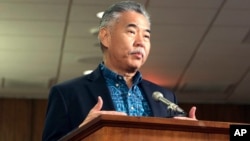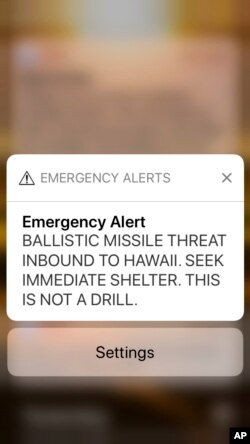The Hawaii National Guard's top commander said Friday he told Gov. David Ige that a missile alert was a false alarm two minutes after it went out statewide. But the governor didn't tell the public until 15 minutes later.
Maj. Gen. Arthur “Joe” Logan told state lawmakers at a hearing that he called the governor at 8:09 a.m. Saturday after speaking to a supervisor at the Hawaii Emergency Management Agency, whose employee accidentally sent the alert.
Ige spokeswoman Cindy McMillan said the governor had to track her down to prepare a message for the public. She said the governor’s communications team handles his social media.
Ige’s office relayed an emergency management agency tweet about the false alarm at 8:24 a.m. Six minutes later, a notice went up on his Facebook page.
Rep. Kaniela Ing, who questioned Logan about the alert mishap, said he wanted to ask the governor himself about the events. But Ige had left the hearing by the time it was Ing’s turn to ask questions.
McMillan said Ige departed the hearing early because he had “various things to do.” In response to criticism from Ing and other lawmakers that Ige left prematurely, McMillan said: “He is the governor. He has other duties to attend to today.”
Lawmakers held their hearing nearly a week after a state employee caused widespread panic and confusion by mistakenly sending an emergency alert to mobile devices and TV and radio stations warning of an incoming missile strike.
A corrected alert was not sent to mobile devices for nearly 40 minutes because state workers had no prepared message for a false alarm.
Hawaii emergency workers immediately started calling city and county officials to tell them there was no threat. They posted social media messages about 13 minutes after the erroneous warning.
A Federal Communications Commission official told the hearing not all cellphones in Hawaii received the alert in part because cellphone carriers may choose not to participate in the nation's Wireless Emergency Alert system.
FCC attorney and adviser James Wiley said some carriers may also offer the service only to some geographic areas and only to some mobile devices. Individuals may also opt out of receiving alerts.
Wiley was visiting Hawaii to investigate why the mistaken alert was sent.
On Thursday, the Hawaii state Department of Defense said it took about 10 minutes for an employee to think of sending a new alert canceling the alert.
Lt. Col. Charles Anthony said that amid the chaos, a telecommunications staffer presented his idea to create a new alert on the same platform that sent out the mistake. The agency checked with federal officials, composed and uploaded the alert to their online system and eventually issued the retraction.
The initial warning was sent at 8:07 a.m. and the correction reached cellphones at 8:45.
It is estimated that a missile would take about 20 minutes to reach Hawaii from North Korea. Officials say it would take about five minutes for the military to analyze the launch trajectory and notify the state, leaving only 12 to 15 minutes of warning time before impact.








